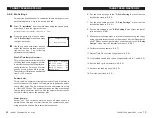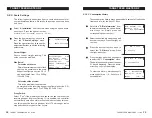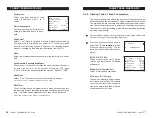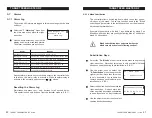
18
TARGET FEED MASTER RF
TARGET FEED MASTER RF rev.09
5.
USING THE CONTROLLER
5.1
First Installation
These are the basic steps to start up your controller. References
to certain sections of the manual are mentioned to step directly to
the parameters' adjustment chapters.
1. Connect the PSFS-1 module according to the wiring diagram en-
closed with the manual :
a) Connect the PSFS-1 to the weighing hopper’s actuator.
b) Short-circuit the 2 DIR terminals of the PSFS-1.
c) Plug the wall transformer in a 115VAC source.
The scale valve should now open. If it does not open, refer to the
troubleshooting guide
at the end of the manual.
2- Connect the controller, the LCT and the TRB modules as shown in
the wiring diagram :
a) Set the ID numbers of each module (s. 5.8.5.1).
b) Remove or lift the cover from LCT and TRB modules.
c) Turn the power ON.
d) Make sure that all loads connected to the TRB modules operate
correctly: use the switches to activate each relay manually.
The controller should now be working properly. The red lights lo-
cated inside the LCT and in the TRB module with ID#2 should be
flashing regularly. If the controller does now work or if the lights
do not flash, refer to the
troubleshooting guide
at the end of the
manual.
3. Adjust the
Date and Time
(s. 5.4).
4. Enter the
Installer Password
(03-05-14 by default) to access the
installation menu (see sec. 5.8.1).
5. Set the main settings of the controller in the "
1.Settings"
menu
from the installation menu (s. 5.8.2).
55
TARGET FEED MASTER RF
TARGET FEED MASTER RF rev.09
Backup bins:
When a bin is empty, it may be replaced by a backup bin. The
selected backup bin keeps being used up until it is empty – even if
the original bin is being refilled. When the backup bin is empty, it
switches to its own backup bin; in other words, the system does
not necessarily returns to the original bin when a backup bin be-
comes empty, it switches to the backup bin's backup bin. This al-
lows a constant feed circulation in each bin.
Since the transition between backup bins is done in a circular mat-
ter, it is highly recommended to create a loop between all bins. This
avoids generating run time alarms when a bin is empty and has no
backup bin. The following graphic illustrates the situation:
BIN 1
BIN 2
BIN 3
BIN 1
BIN 2
BIN 3






























